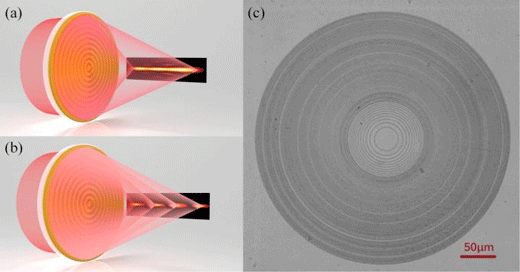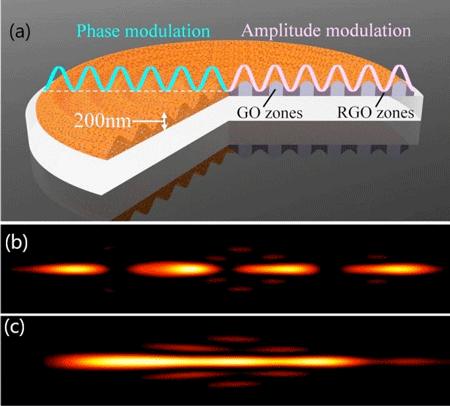| Apr 16, 2021 |
Generation of super-resolved optical needle and multifocal array using graphene oxide metalenses
(Nanowerk News) In a new publication from Opto-Electronic Advances ("Generation of super-resolved optical needle and multifocal array using graphene oxide metalenses"), Researchers led by Professor Baohua Jia at Swinburne University of Technology, Victoria, Australia, Professor Cheng-Wei Qiu at National University of Singapore, Singapore and Professor Tian Lan at Beijing Institute of Technology, Beijing, China considered the generation of super-resolved optical needle and multifocal array using graphene oxide metalenses.
|
|
Ultrathin and lightweight, metalenses are becoming increasingly significant for their use in photonic chips, biosensors and micro imaging systems such as smart phone cameras.
|
 |
| Demonstration of GO metalens and its characterization. (a) Optical demonstration for optical needle generated by GO metalens. (b) Optical demonstration for four axial focal spots generated by GO metalens. (c) Optical image of GO metalens taken by an optical microscope with an objective of ×20, NA=0.5, the scale bar is 50 µm. (© Opto-Electronic Advances)
|
|
Compared to conventional lenses, metalenses can improve the image quality of current cameras, by enhancing resolution and removing spherical and chromatic aberrations. A single ultrathin (less than the thickness of 1/100 of a human hair) metalens element can be used instead of the multiple element imaging systems required by conventional lenses.
|
|
Due to the unique light-matter interaction in a confined 2D plane, 2D materials are ideal for use with metalenses, further reducing the required thickness of the lens. 2D graphene family materials, for example graphene oxides, are air-stable, have many applications and are low-cost and easy to fabricate in large scale. They remain stable in extreme environments, for example lower earth orbit in aerospace, so have potential use in satellites replacing the current bulky lenses and improving imaging quality and lowering launch costs.
|
|
The authors of this article developed 200 nm thick graphene oxide metalenses to generate specialized focal intensity distributions. The graphene oxide metalenses have the capability of controlling light amplitude (i.e., transparency of the lens) and phase (refractive index and thickness of the lens) simultaneously.
|
|
This differs from other metalenses, which introduce the modulations through multi-step nanofabrication or multilevel of nano-elements, the modulations of graphene oxide lenses are locally introduced by the laser photo-reduction process, which converts graphene oxide to graphene material. During the reduction process, the material becomes thinner and has a higher refractive index and absorption.
|
|
Based on the simultaneous phase and amplitude modulations, the authors demonstrate precise control of the focal intensity distributions by creating a super-resolved ultra-long optical needle and an axial multifocal array, which are extremely challenging for other metalenses.
|
 |
| (a) Schematic figure of GO metalens on a glass substrate, the total thickness is 200 nm. When reduced by femtosecond laser in RGO area, the absorption and refractive index increase while the thickness is reduced to 100 nm. Normalized intensity distribution in the x-z plane from theoretical calculation of the focusing characterization of (b) axial multifocal spots GO metalens and (c) optical needle GO metalens, respectively. (© Opto-Electronic Advances)
|
|
Graphene oxide metalenses will find broad applications in integrated photonics and compact photonic systems, including microscopic imaging, optical manipulation and photonic chips, and can be integrated on microfluidic chips to form lab-on-a-chip biophotonic devices.
|
|
This research forms a basis for the development of graphene-based ultrathin integratable photonic devices and paves the way for broader applications, such as replacing current cell phone camera lens potentially allowing a reduction in the thickness of current cell phones.
|


